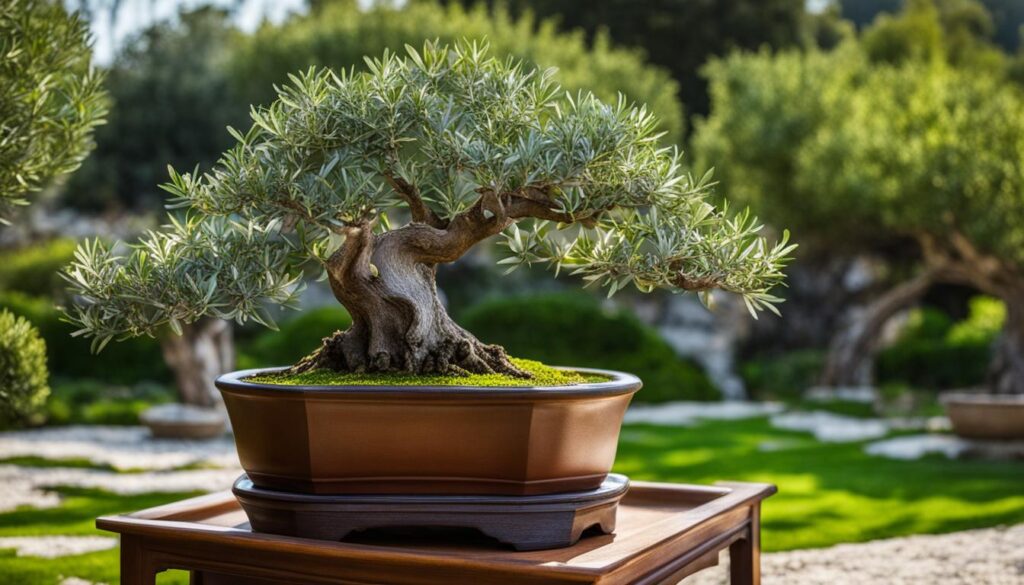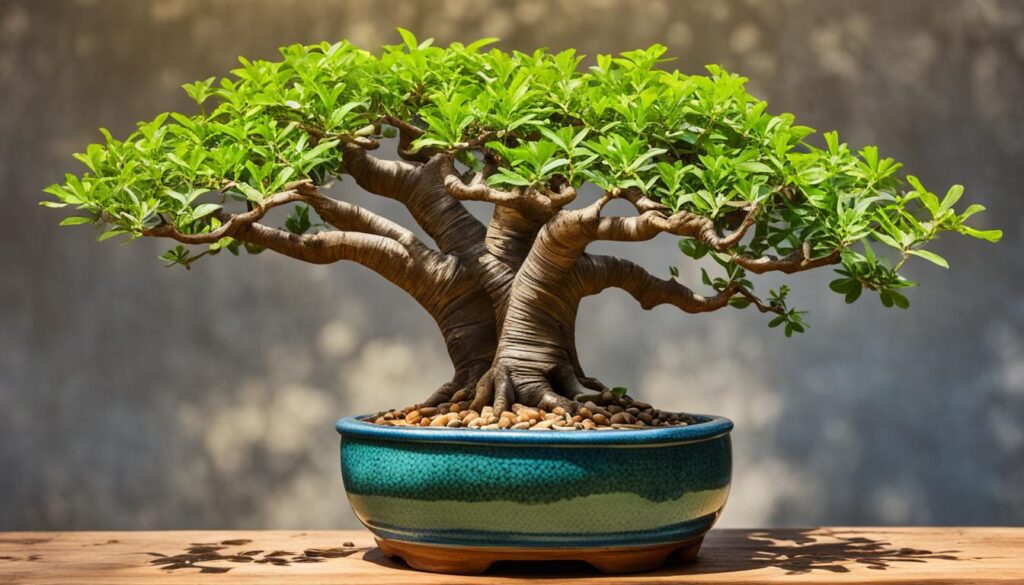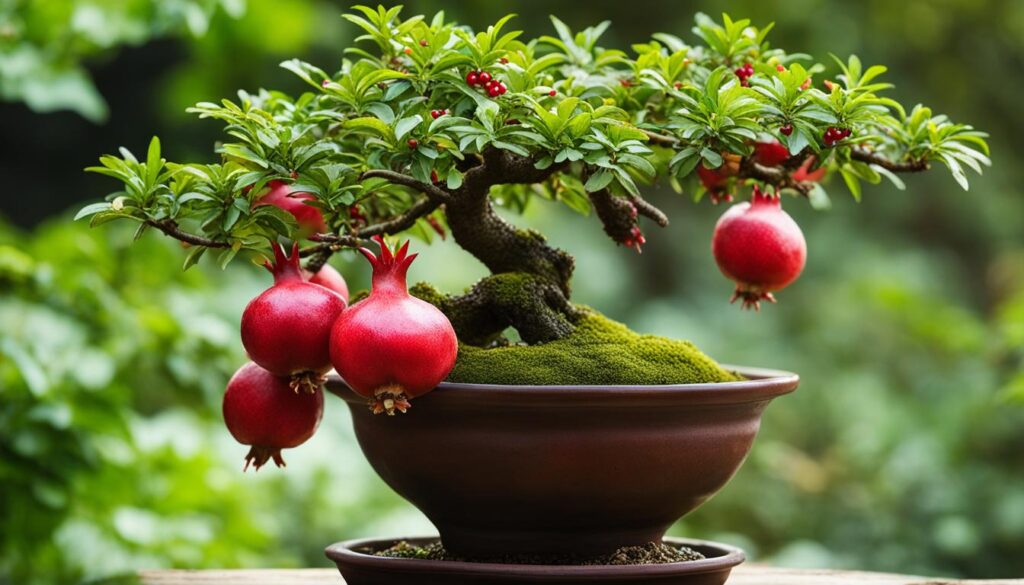Olive tree bonsais, with their unique traits and requirements, offer a captivating and rewarding bonsai experience. By following the proper care techniques, you can create a miniature masterpiece that adds elegance and beauty to any space.
Throughout this guide, we’ll explore the exceptional hardy nature of miniature olive trees, the identifying characteristics of different bonsai olive tree varieties, and the historical significance and symbolism encompassing olive bonsais.
Let’s delve into the world of olive tree bonsai and uncover the secrets to nurturing these magnificent trees.
Understanding the Unique Traits of Olive Tree Bonsai
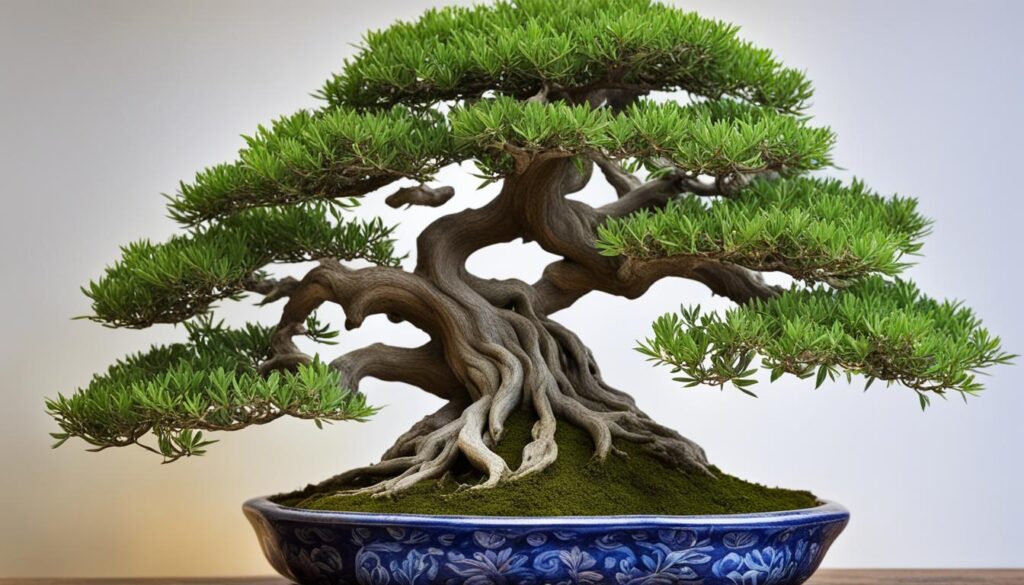
Olive tree bonsais have unique traits that distinguish them from other bonsai types. Let’s examine these characteristics and their importance.
The Exceptional Hardy Nature of Miniature Olive Trees
Miniature olive trees are popular for bonsai cultivation due to their hardiness. They can endure cold weather and dry conditions, making them suitable for different climates. Their resilience allows them to thrive in tough environments, making them a favored option for bonsai enthusiasts looking for a strong and lasting tree.
Identifying Characteristics of Bonsai Olive Tree Varieties
Bonsai olive trees include various varieties, each with distinct characteristics. These traits can vary in leaf color, shape, and growth patterns. By choosing from different olive tree varieties, bonsai lovers can create unique and interesting bonsai displays.
Historical Significance and Symbolism Encompassing Olive Bonsais
Olive trees hold significant historical meaning and symbolize concepts that connect cultures across time. They are closely linked to peace, wisdom, and longevity. The ancient Greeks honored the olive tree as a symbol of peace, and its branches continue to feature in ceremonies and traditions. Adding an olive tree bonsai to your collection can introduce historical significance and deep meaning to your bonsai experience.
“The olive tree is surely the richest gift of Heaven. I can scarcely expect bread.” – Thomas Jefferson
Appreciate the unique traits and meaningful symbolism of olive tree bonsais as you start your bonsai cultivation journey. The hardy nature of miniature olive trees along with their variety and historical significance make them an excellent choice for bonsai enthusiasts looking for a captivating and significant bonsai experience.
The Ideal Environment for Cultivating an Olive Tree Bonsai
Creating the right environment is crucial for the successful growth of an olive tree bonsai. These trees thrive in full sun and require protection from frost. While they can tolerate slightly below freezing temperatures, it’s best to keep them in a cold greenhouse to ensure their health. Proper lighting, temperature, and moisture levels are important for creating the ideal environment for your olive tree bonsai.
When it comes to lighting, olive tree bonsais need at least six hours of direct sunlight each day. Place your bonsai near a south-facing window or use grow lights to provide the necessary light intensity. This ensures that your tree receives the energy it needs for photosynthesis and healthy growth.
The temperature is another important factor to consider. Olive tree bonsais prefer warm temperatures between 65°F and 85°F (18°C and 29°C). Avoid exposing your bonsai to extreme heat or cold, as it can stress the tree and hinder its growth. If you live in an area with harsh winters, it’s best to provide protection, such as moving the bonsai indoors or using a greenhouse.
Moisture levels play a vital role in the health of your olive tree bonsai. It’s important to strike a balance between underwatering and overwatering. Allow the soil to slightly dry out between waterings to avoid root rot, but avoid letting it completely dry out. Use well-draining soil and water thoroughly, ensuring that the excess water drains out through the drainage holes of the bonsai pot.
To give you a better understanding of the ideal environment for olive tree bonsais, take a look at the table below:
| Environmental Factor | Ideal Conditions |
|---|---|
| Light | At least 6 hours of direct sunlight per day or grow lights |
| Temperature | 65°F to 85°F (18°C to 29°C) |
| Moisture | Allow soil to slightly dry out between waterings |
| Protection | Shield from frost and extreme temperatures |
By providing the ideal environment for your olive tree bonsai, you’ll set the stage for healthy growth and vibrant foliage. Always monitor the conditions and make adjustments as necessary to ensure the well-being of your bonsai tree.
Olive Tree Bonsai Watering Rituals
Watering is a fundamental aspect of bonsai care, and when it comes to olive tree bonsais, specific watering rituals are essential for their health and vitality. These magnificent bonsai trees require thorough watering whenever the soil becomes dry, but it’s crucial to avoid overwatering and constant wetness. By understanding and implementing proper watering techniques, you can ensure the optimal growth and well-being of your olive tree bonsai.
When it comes to watering your olive tree bonsai, it’s important to strike the right balance. Follow these tips and techniques to establish a successful watering routine:
- Observe the soil: Regularly check the moisture level of the soil by gently inserting your finger about an inch deep. Water your olive tree bonsai only when the soil feels dry at this depth.
- Thorough watering: When it’s time to water, make sure to thoroughly soak the soil until water drains from the drainage holes at the bottom of the bonsai container. This ensures proper hydration and allows the roots to absorb the necessary moisture.
- Avoid overwatering: Overwatering can lead to root rot and other water-related issues. It’s essential to let the soil dry out slightly between waterings to prevent waterlogged conditions. Always remember that olive tree bonsais prefer a slightly drier environment compared to other bonsai varieties.
- Consider the environmental conditions: Factors such as temperature, humidity, and sunlight exposure can influence the watering needs of your olive tree bonsai. During hot and dry periods, you may need to water more frequently, while cooler and more humid conditions may require less frequent watering.
By following these watering rituals, you can provide your olive tree bonsai with the optimal moisture balance it needs for healthy growth and development. Remember, maintaining a consistent watering schedule is key, but always adapt it to the specific needs of your bonsai by closely monitoring the soil moisture and environmental conditions.
Feeding Your Bonsai: Fertilization Strategies for Olive Tree Bonsai
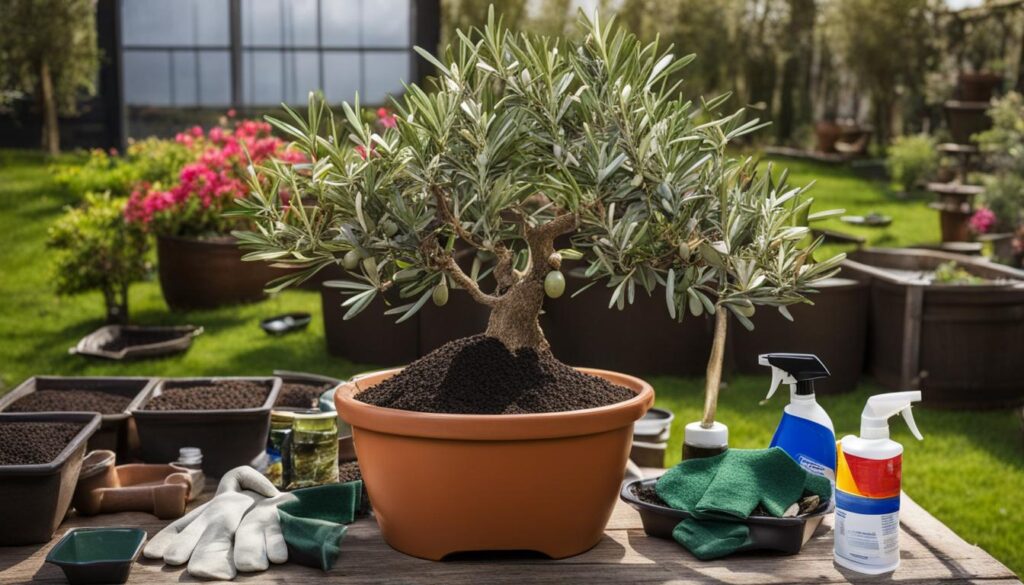
Fertilizing your olive tree bonsai is essential for providing it with the necessary nutrients for growth and overall health. A well-fed bonsai tree is more likely to exhibit vibrant foliage, strong branches, and robust root development. By understanding and implementing proper feeding techniques, you can ensure that your olive tree bonsai receives the right amount of nutrients to thrive.
There are several fertilization strategies you can employ to nourish your bonsai olive trees:
- Use solid organic fertilizer: Solid organic fertilizers, such as slow-release pellets or granules, are an excellent choice for feeding your olive tree bonsai. These fertilizers gradually release nutrients over an extended period, providing a steady supply of essential elements. Apply the recommended amount according to the manufacturer’s instructions, and be sure to distribute it evenly around the base of the tree.
- Opt for liquid fertilizer: Liquid fertilizers offer a quicker nutrient uptake for your olive tree bonsai. They are easily absorbed by the roots, allowing the tree to access the nutrients rapidly. Dilute the liquid fertilizer according to the package instructions, and apply it to your bonsai’s soil during the growing season. Take care not to over-fertilize, as excessive nutrients can lead to leaf burn or root damage.
- Consider the nutrient requirements: Olive tree bonsais have specific nutritional needs that you should be mindful of. They typically require a balanced fertilizer with a ratio of nitrogen (N), phosphorus (P), and potassium (K) such as a 10-10-10 or 20-20-20 fertilizer. Nitrogen promotes leaf and stem growth, phosphorus aids in root development, and potassium enhances overall plant vigor. Adjust the fertilizer formulation based on the specific requirements of your olive tree bonsai.
It’s important to follow a regular fertilization schedule, providing your bonsai with nutrients at the appropriate times. During the active growing season, typically spring and early summer, your olive tree bonsai will require more frequent fertilization. As the tree enters dormancy in the fall and winter, reduce or stop fertilizing to accommodate its natural growth cycles.
To determine the optimal amount and frequency of fertilization, monitor the growth and health of your bonsai tree. Adjust the feeding regimen accordingly based on its response and any specific needs it may have.
By incorporating these fertilization strategies into your olive tree bonsai care routine, you can nourish your bonsai tree and promote its overall well-being. Remember to always consider the unique needs of your bonsai, regularly observe its growth patterns, and provide it with the appropriate nutrients to ensure its long-term health and vitality.
Pruning and Wiring Your Olive Tree Bonsai
Pruning and wiring are vital techniques for shaping and maintaining the desired form of your olive tree bonsai. To ensure the health and aesthetic appeal of your bonsai, it’s important to understand when and how to properly prune and wire your tree.
Pruning: Pruning involves selectively removing branches, leaves, and roots to achieve the desired shape and size. The main purposes of pruning are to encourage branching, control growth, and maintain the bonsai’s overall balance. Begin by removing any dead, damaged, or weak branches. Then, carefully trim back the remaining branches to achieve the desired shape. Remember to always use clean and sharp pruning shears to prevent damage and disease.
Wiring: Wiring is a technique used to shape the branches and trunk of your olive tree bonsai. By using bonsai wire, you can guide the growth and position of the branches, creating a pleasing aesthetic appearance. Start by choosing the appropriate thickness and length of wire for each branch. Gently wrap the wire around the branch, starting from the base and working towards the tip. Be careful not to wrap the wire too tightly as it may damage the branch. After a few months, the wire can be removed or replaced with a larger one to allow the branch to set in the desired shape.
Pruning and wiring should be done with care and precision, as improper techniques can harm your olive tree bonsai. It is recommended to learn from experienced bonsai enthusiasts or seek guidance from a professional to master these techniques effectively.
Repotting Procedures for Olive Tree Bonsai
Repotting is an essential part of bonsai care, and olive tree bonsais require repotting every two or three years. By repotting your olive tree bonsai, you provide it with fresh soil, essential nutrients, and ample space for root growth, ensuring its continued health and vitality.
When it comes to repotting your olive tree bonsai, timing is crucial. The optimal time for repotting is during the early spring before new growth starts. This allows the tree to recover from any root pruning and adapt to its new environment.
The first step in the repotting process is to carefully remove the bonsai from its current pot. Gently loosen the soil around the roots with a root rake or chopstick, being careful not to damage the delicate root structure.
Next, carefully prune the roots to encourage new growth. Trim away any overly long or damaged roots, making sure to maintain a balance between the roots and the foliage above. This will help ensure that the tree remains healthy and well-proportioned.
After root pruning, it’s time to select the right soil mix for your olive tree bonsai. A well-draining soil with a good balance of organic matter and inorganic particles is ideal. Avoid heavy soils that retain excess moisture, as this can lead to root rot.
Once you have prepared the soil mix, place a layer of fresh soil in the bottom of the new pot. Position the bonsai in the pot, making sure that it is centered and at the desired angle. Fill the remaining space with the soil mix, gently firming it around the roots to eliminate any air pockets.
After repotting, it’s crucial to thoroughly water the bonsai to settle the soil around the roots. Place the bonsai in a shaded area for a few weeks, gradually reintroducing it to full sunlight. This will help reduce stress on the tree and promote its recovery.
Remember to monitor the moisture levels and provide proper care as the bonsai adjusts to its new pot. Regular watering, fertilization, and attention to pruning and wiring will ensure the continued health and beauty of your olive tree bonsai.
By following these step-by-step repotting procedures, you can ensure the long-term success of your olive tree bonsai and enjoy its beauty for years to come.
Common Pests and Diseases in Olive Tree Bonsai Care
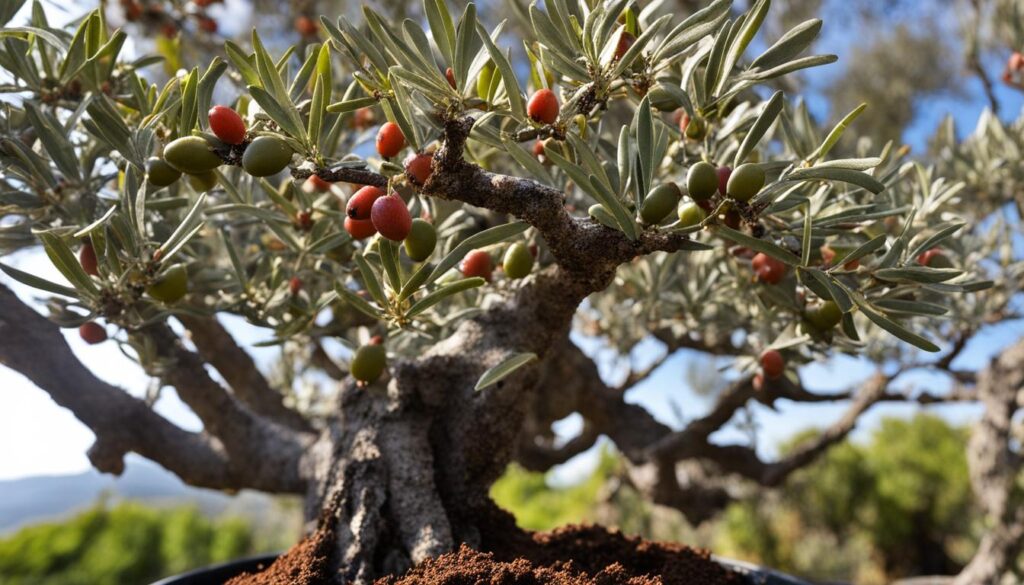
Just like any other plant, olive tree bonsais are prone to pests and diseases that can impact their health and overall vitality. It’s important to be vigilant and proactive in identifying and addressing these issues to preserve the beauty of your olive tree bonsai. In this section, we’ll explore the common pests and diseases that you might encounter in bonsai olive tree care, along with possible remedies and prevention strategies.
Common Pests in Olive Tree Bonsai
Pests can cause significant damage to your olive tree bonsai if left unchecked. Here are some common pests to be wary of:
- Scale: These small, sap-sucking insects can be found on the leaves and branches of your bonsai. Look out for small brown or black bumps on the plant surface.
- Mealybugs: Mealybugs are soft-bodied pests that often appear as white, waxy clusters on your bonsai tree. They feed on the plant sap, causing yellowing and stunted growth.
Olive Tree Bonsai Diseases
In addition to pests, your olive tree bonsai may also be susceptible to certain diseases. Understanding these diseases can help you take appropriate preventive measures:
- Fungal Diseases: Fusarium wilt, root rot, and powdery mildew are some common fungal diseases that can affect your bonsai olive tree. These diseases can cause wilting, yellowing leaves, and overall decline in the health of the plant.
- Bacterial Infections: Bacterial infections, such as bacterial leaf spot, can lead to the development of dark spots on the leaves and stems of your bonsai. If left untreated, these infections can spread and damage the plant.
Prevention and Treatment
The key to dealing with pests and diseases in olive tree bonsai care is prevention. Here are some preventive measures to keep in mind:
- Regularly inspect your bonsai tree for any signs of pests or diseases.
- Maintain good hygiene by regularly removing dead leaves and cleaning the bonsai’s growing area.
- Ensure proper air circulation and sunlight exposure to promote a healthy environment for your bonsai.
- Use organic pest control methods, such as neem oil or insecticidal soaps, to treat infestations.
- If the infestation or disease persists, consult a bonsai expert or horticulturist for proper diagnosis and treatment.
By taking these preventive measures and promptly addressing any issues, you can ensure the long-term health and beauty of your olive tree bonsai.
Propagation Techniques for Olive Tree Bonsai Enthusiasts
If you’re an olive tree bonsai enthusiast, you may have considered propagating your own trees. Propagation allows you to expand your collection and create new olive tree bonsais. There are two common techniques for propagating bonsai olive trees: from seeds and from cuttings.
If you choose to propagate from seeds, start by harvesting the ripe olive fruits. Extract the seeds, clean them, and soak them in water for a day or two. After soaking, plant the seeds in a well-draining potting mix, covering them lightly with soil. Keep the soil consistently moist and place the pot in a warm location. With patience, your olive tree bonsais will begin to sprout.
Another option is propagation from cuttings. Choose healthy olive tree branches that are about pencil-thick. Cut the branch into sections, ensuring each section has at least two nodes. Dip the cut end of the section in rooting hormone and plant it in a pot filled with a well-draining soil mixture. Maintain a moist environment, either by using a humidity dome or misting the cuttings regularly. Over time, the cuttings will develop roots and grow into new bonsai olive trees.
If you’re not up for the challenge of propagating your own olive tree bonsais, you can also find them for sale. Many reputable nurseries and online retailers offer a wide variety of olive tree bonsais for purchase. Make sure to select healthy trees that suit your preferences and needs. Buying established bonsais can save you time and effort, allowing you to enjoy the beauty of these miniature olive trees right away.
Unleash the Magic: Transform Your Holidays with the Ultimate Bonsai Christmas Tree Guide! >>>
Is Your Bonsai Tree Dying? Discover the Shocking Truth Behind Yellow Leaves! >>>

